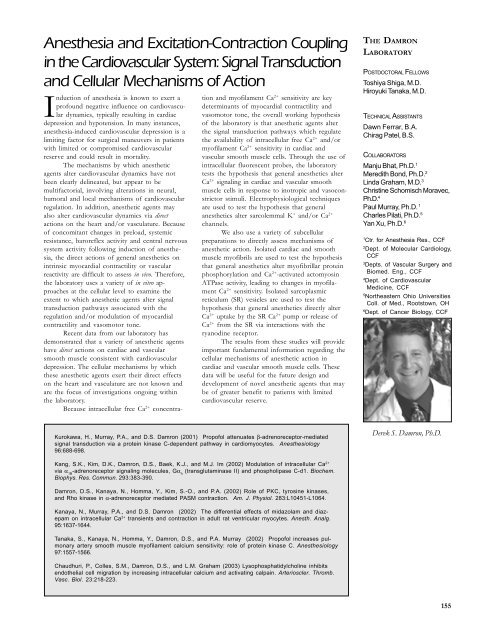Scientific Report 2003-2004 - Cleveland Clinic Lerner Research ...
Scientific Report 2003-2004 - Cleveland Clinic Lerner Research ...
Scientific Report 2003-2004 - Cleveland Clinic Lerner Research ...
- No tags were found...
You also want an ePaper? Increase the reach of your titles
YUMPU automatically turns print PDFs into web optimized ePapers that Google loves.
Anesthesia and Excitation-Contraction Couplingin the Cardiovascular System: Signal Transductionand Cellular Mechanisms of ActionInduction of anesthesia is known to exert aprofound negative influence on cardiovasculardynamics, typically resulting in cardiacdepression and hypotension. In many instances,anesthesia-induced cardiovascular depression is alimiting factor for surgical maneuvers in patientswith limited or compromised cardiovascularreserve and could result in mortality.The mechanisms by which anestheticagents alter cardiovascular dynamics have notbeen clearly delineated, but appear to bemultifactorial, involving alterations in neural,humoral and local mechanisms of cardiovascularregulation. In addition, anesthetic agents mayalso alter cardiovascular dynamics via directactions on the heart and/or vasculature. Becauseof concomitant changes in preload, systemicresistance, baroreflex activity and central nervoussystem activity following induction of anesthesia,the direct actions of general anesthetics onintrinsic myocardial contractility or vascularreactivity are difficult to assess in vivo. Therefore,the laboratory uses a variety of in vitro approachesat the cellular level to examine theextent to which anesthetic agents alter signaltransduction pathways associated with theregulation and/or modulation of myocardialcontractility and vasomotor tone.Recent data from our laboratory hasdemonstrated that a variety of anesthetic agentshave direct actions on cardiac and vascularsmooth muscle consistent with cardiovasculardepression. The cellular mechanisms by whichthese anesthetic agents exert their direct effectson the heart and vasculature are not known andare the focus of investigations ongoing withinthe laboratory.Because intracellular free Ca 2+ concentrationand myofilament Ca 2+ sensitivity are keydeterminants of myocardial contractility andvasomotor tone, the overall working hypothesisof the laboratory is that anesthetic agents alterthe signal transduction pathways which regulatethe availability of intracellular free Ca 2+ and/ormyofilament Ca 2+ sensitivity in cardiac andvascular smooth muscle cells. Through the use ofintracellular fluorescent probes, the laboratorytests the hypothesis that general anesthetics alterCa 2+ signaling in cardiac and vascular smoothmuscle cells in response to inotropic and vasoconstrictorstimuli. Electrophysiological techniquesare used to test the hypothesis that generalanesthetics alter sarcolemmal K + and/or Ca 2+channels.We also use a variety of subcellularpreparations to directly assess mechanisms ofanesthetic action. Isolated cardiac and smoothmuscle myofibrils are used to test the hypothesisthat general anesthetics alter myofibrillar proteinphosphorylation and Ca 2+ -activated actomyosinATPase activity, leading to changes in myofilamentCa 2+ sensitivity. Isolated sarcoplasmicreticulum (SR) vesicles are used to test thehypothesis that general anesthetics directly alterCa 2+ uptake by the SR Ca 2+ pump or release ofCa 2+ from the SR via interactions with theryanodine receptor.The results from these studies will provideimportant fundamental information regarding thecellular mechanisms of anesthetic action incardiac and vascular smooth muscle cells. Thesedata will be useful for the future design anddevelopment of novel anesthetic agents that maybe of greater benefit to patients with limitedcardiovascular reserve.THE DAMRONLABORATORYPOSTDOCTORAL FELLOWSToshiya Shiga, M.D.Hiroyuki Tanaka, M.D.TECHNICAL ASSISTANTSDawn Ferrar, B.A.Chirag Patel, B.S.COLLABORATORSManju Bhat, Ph.D. 1Meredith Bond, Ph.D. 2Linda Graham, M.D. 3Christine Schomisch Moravec,Ph.D. 4Paul Murray, Ph.D. 1Charles Pilati, Ph.D. 5Yan Xu, Ph.D. 61Ctr. for Anesthesia Res., CCF2Dept. of Molecular Cardiology,CCF3Depts. of Vascular Surgery andBiomed. Eng., CCF4Dept. of CardiovascularMedicine, CCF5Northeastern Ohio UniversitiesColl. of Med., Rootstown, OH6Dept. of Cancer Biology, CCFKurokawa, H., Murray, P.A., and D.S. Damron (2001) Propofol attenuates β-adrenoreceptor-mediatedsignal transduction via a protein kinase C-dependent pathway in cardiomyocytes. Anesthesiology96:688-698.Derek S. Damron, Ph.D.Kang, S.K., Kim, D.K., Damron, D.S., Baek, K.J., and M.J. Im (2002) Modulation of intracellular Ca 2+via α 1B-adrenoreceptor signaling molecules, Gα h(transglutaminase II) and phospholipase C-d1. Biochem.Biophys. Res. Commun. 293:383-390.Damron, D.S., Kanaya, N., Homma, Y., Kim, S.-O., and P.A. (2002) Role of PKC, tyrosine kinases,and Rho kinase in α-adrenoreceptor mediated PASM contraction. Am. J. Physiol. 283:L10451-L1064.Kanaya, N., Murray, P.A., and D.S. Damron (2002) The differential effects of midazolam and diazepamon intracellular Ca 2+ transients and contraction in adult rat ventricular myocytes. Anesth. Analg.95:1637-1644.Tanaka, S., Kanaya, N., Homma, Y., Damron, D.S., and P.A. Murray (2002) Propofol increases pulmonaryartery smooth muscle myofilament calcium sensitivity: role of protein kinase C. Anesthesiology97:1557-1566.Chaudhuri, P., Colles, S.M., Damron, D.S., and L.M. Graham (<strong>2003</strong>) Lysophosphatidylcholine inhibitsendothelial cell migration by increasing intracellular calcium and activating calpain. Arterioscler. Thromb.Vasc. Biol. 23:218-223.155
















